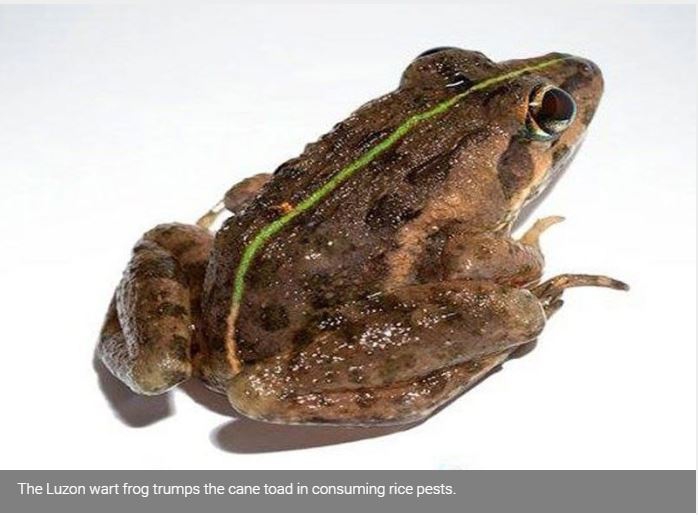| Citation |
IUCN SSC Amphibian Specialist Group 2018. Fejervarya vittigera. The IUCN Red List of Threatened Species 2018: e.T58294A114915259. http://dx.doi.org/10.2305/IUCN.UK.2018-2.RLTS.T58294A114915259.en. Downloaded on 09 May 2019. |
Description |
Geographic Range
NATIVE
Extant (resident)
Philippines
NUMBER OF LOCATIONS
UPPER ELEVATION LIMIT
1,000 metres
LOWER ELEVATION LIMIT
0 metres
UPPER DEPTH LIMIT
LOWER DEPTH LIMIT
Geographic Range in detail
ESTIMATED AREA OF OCCUPANCY (AOO) (KM²)
CONTINUING DECLINE IN AREA OF OCCUPANCY (AOO)
EXTREME FLUCTUATIONS IN AREA OF OCCUPANCY (AOO)
ESTIMATED EXTENT OF OCCURRENCE (EOO) (KM²)
1024402
CONTINUING DECLINE IN EXTENT OF OCCURRENCE (EOO)
EXTREME FLUCTUATIONS IN EXTENT OF OCCURRENCE (EOO)
CONTINUING DECLINE IN NUMBER OF LOCATIONS
EXTREME FLUCTUATIONS IN THE NUMBER OF LOCATIONS
RANGE DESCRIPTION
This species occurs on all the major islands in the Philippines, between 0-1,000 m asl (A. Diesmos pers. comm. March 2018).
Population
CURRENT POPULATION TREND
Decreasing
NUMBER OF MATURE INDIVIDUALS
POPULATION SEVERELY FRAGMENTED
No
CONTINUING DECLINE OF MATURE INDIVIDUALS
Population in detail
EXTREME FLUCTUATIONS
NO. OF SUBPOPULATIONS
CONTINUING DECLINE IN SUBPOPULATIONS
EXTREME FLUCTUATIONS IN SUBPOPULATIONS
ALL INDIVIDUALS IN ONE SUBPOPULATION
NO. OF INDIVIDUALS IN LARGEST SUBPOPULATION
DESCRIPTION
It is abundant and common where present. There may be some local subpopulation declines caused by invasive amphibian species based on field observations (A. Diesmos pers. comm. March 2018).
Habitat and Ecology
SYSTEM
Terrestrial, Freshwater (=Inland waters)
HABITAT TYPE
Artificial/Terrestrial, Artificial/Aquatic & Marine, Introduced vegetation, Grassland, Shrubland, Wetlands (inland)
GENERATION LENGTH (YEARS)
CONGREGATORY
MOVEMENT PATTERNS
Not a Migrant
CONTINUING DECLINE IN AREA, EXTENT AND/OR QUALITY OF HABITAT
Habitat and Ecology in detail
HABITAT AND ECOLOGY
This species is usually found in anthropogenic habitats such as agricultural areas, ditches, artificial ponds, and lakes. It is also found in swamp forest (A. Diesmos pers. comm. March 2018). It breeds by larval development in nearly any body of available water.
CLASSIFICATION SCHEME
Habitats Suitability Major importance
3. Shrubland 3.6. Shrubland - Subtropical/Tropical Moist Marginal
4. Grassland 4.6. Grassland - Subtropical/Tropical Seasonally Wet/Flooded Suitable Yes
5. Wetlands (inland) 5.5. Wetlands (inland) - Permanent Freshwater Lakes (over 8ha) Marginal
5.6. Wetlands (inland) - Seasonal/Intermittent Freshwater Lakes (over 8ha) Suitable Yes
5.7. Wetlands (inland) - Permanent Freshwater Marshes/Pools (under 8ha) Suitable Yes
5.8. Wetlands (inland) - Seasonal/Intermittent Freshwater Marshes/Pools (under 8ha) Suitable Yes
14. Artificial/Terrestrial 14.1. Artificial/Terrestrial - Arable Land Suitable No
14.2. Artificial/Terrestrial - Pastureland Suitable No
14.3. Artificial/Terrestrial - Plantations Marginal
15. Artificial/Aquatic & Marine 15.1. Artificial/Aquatic - Water Storage Areas (over 8ha) Suitable No
15.2. Artificial/Aquatic - Ponds (below 8ha) Suitable No
15.3. Artificial/Aquatic - Aquaculture Ponds Suitable No
15.5. Artificial/Aquatic - Excavations (open) Marginal
15.6. Artificial/Aquatic - Wastewater Treatment Areas Marginal
15.7. Artificial/Aquatic - Irrigated Land (includes irrigation channels) Suitable No
15.8. Artificial/Aquatic - Seasonally Flooded Agricultural Land Suitable No
15.9. Artificial/Aquatic - Canals and Drainage Channels, Ditches Suitable No
16. Introduced vegetation
Threats
Biological resource use
Hunting & trapping terrestrial animals
Invasive and other problematic species, genes & diseases
Invasive non-native/alien species/diseases
Threats in detail
THREATS
Available information indicates that this species is not subject to any significant degree of disturbance, which could threaten its survival at present. However, it is harvested for food, although not at levels that constitute a major threat to it. Invasive species Hoplobatrachus rugosus and Kaloula pulchra are now widespread across the Philippines and, in areas where this species occurs, there have been some possible observed declines in subpopulations although it is not considered to be a major threat (A. Diesmos pers. comm. March 2018). In areas where all three species co-occur, local communities have shifted to harvesting the two invasive species for food, which may have lessened the impact on this native species (A. Diesmos pers. comm. March 2018).
CLASSIFICATION SCHEME
Threats Timing Stresses Scope Severity Impact score Invasive species Virus
5. Biological resource use 5.1. Hunting & trapping terrestrial animals 5.1.1. Intentional use (species is the target) Ongoing
2. Species Stresses 2.1. Species mortality
Minority (<50%) Negligible declines Low Impact: 4
8. Invasive and other problematic species, genes & diseases 8.1. Invasive non-native/alien species/diseases 8.1.2. Named species Ongoing
2. Species Stresses 2.1. Species mortality
Unknown Causing/Could cause fluctuations Unknown Hoplobatrachus rugulosus
Use and Trade
Food - human
Local: ?National: ?International: ?
Use and Trade in detail
USE AND TRADE
This species is harvested for food by local communities, but not at levels that constitute a major threat to the species (A. Diesmos pers. comm. March 2018). |

